Path Coverage
Introduction
Path coverage is a type of software testing technique that ensures that every path through the program has been executed at least once. This method is a part of white box testing techniques, where the internal logic of the system being tested is known to the tester.


Understanding Path Coverage
Path coverage is based on the concept of control flow graph (CFG). A control flow graph is a graphical representation of all paths that might be traversed through a program during its execution. In path coverage, the aim is to cover all the paths from the start to the end of a program, including all possible loops.
Path coverage is more powerful than statement coverage and branch coverage, as it covers all the paths, including those that are not covered by statement and branch coverage. However, it is also more complex and time-consuming, as the number of possible paths in a program can be large, especially if the program contains loops.
Importance of Path Coverage
Path coverage is important because it ensures that all paths in a program are tested, including those that might not be covered by other testing techniques. This can help to uncover bugs that might not be detected by other testing methods.
Moreover, path coverage can provide a measure of the thoroughness of the testing. A high level of path coverage indicates that the testing has been thorough and that the program has been well tested.
However, achieving 100% path coverage can be difficult, especially for large and complex programs. In some cases, it may not be feasible or practical to achieve 100% path coverage. Therefore, testers often aim to achieve a high level of path coverage, rather than aiming for 100% coverage.
Calculating Path Coverage
Path coverage is calculated by dividing the number of paths that have been executed by the total number of paths in the program. The result is usually expressed as a percentage.
For example, if a program has 10 paths and 7 of them have been executed during testing, the path coverage would be 70%.
Calculating path coverage can be complex, especially for large and complex programs. There are tools available that can help to calculate path coverage, such as code coverage tools.
Limitations of Path Coverage
While path coverage is a powerful testing technique, it has some limitations.
Firstly, path coverage can be difficult to achieve for large and complex programs. The number of possible paths in a program can be very large, especially if the program contains loops. In such cases, achieving 100% path coverage may not be feasible.
Secondly, path coverage does not guarantee that all bugs will be found. While it can help to uncover bugs that might not be detected by other testing methods, it is still possible for bugs to go undetected.
Finally, path coverage can be time-consuming and resource-intensive. It requires a significant amount of time and effort to cover all the paths in a program, especially for large and complex programs.
